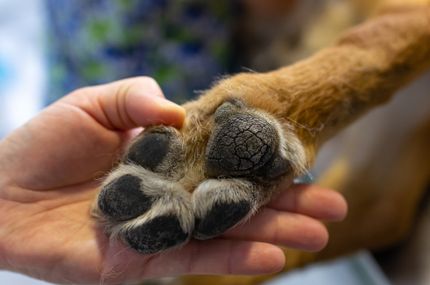Vizmaraner:Magyar Vizsla and Weimaraner Mix
Facts & Origin
Magyar Vizsla and Weimaraner mix - a hybrid breed
The Magyar Vizsla is a mix of the Vizsla and the Weimaraner. They are both highly intelligent, strong-willed dogs that need a firm but loving hand. The Magyar Vizsla is an active dog that needs lots of exercise, but it is also very affectionate and makes an excellent family dog.
| Alternate Name | - |
| Origin | Hungary - Germany |
| Life expectancy | 12 - 15 years |
| Care requirements | low-maintenance |
| Activity level | average to high - high |
| FCI group | not recognised |
| AKC group | not recognised |
| KC group | not recognised |
More Magyar Vizsla mixes
More Weimaraner mixes
Attitude, character and temperament of the breed
Possible character traits of Magyar Vizsla and Weimaraner mix - Such is probably his nature.
The Magyar Vizsla is a popular Hungarian dog that was originally bred as a hunting companion. These dogs are known for their playful and friendly nature and make excellent family dogs. However, they do need a lot of exercise and attention.
The Weimaraner is another popular hunting dog breed that is also known for its friendly and playful nature. However, Weimaraners can be a bit more reserved than Magyar Vizslas. Both breeds are great family dogs and get along great with children.
So what happens when you mix these two breeds together? You get a Magyar Vizsla-Weimaraner mix! These dogs are the best of both worlds. They are friendly and outgoing like the Vizsla, but they are also a bit more reserved than the Weimaraner.
Magyar Vizsla-Weimaraner mixes make great family dogs. They are loyal and loving and love to play. These dogs need a lot of exercise, so they are best suited for families with an active lifestyle. If you are looking for a loyal and loving companion, a Magyar Vizsla Weimaraner mix is the perfect dog for you!
Character
Usage


Health and breeding information
What diseases can occur in Magyar Vizsla and Weimaraner mix.
The Magyar Vizsla Weimaraner mix is a relatively new dog breed that has not been extensively researched. However, there are some known health problems associated with this breed.
One of the most common health problems in Magyar Vizsla Weimaraners is hip and elbow dysplasia. This is a condition where the joints are not formed properly, which can lead to pain and lameness. It is important to have your dog examined by a veterinarian if you suspect this condition, as it can be treated with medication and/or surgery.
Another health problem in this breed is von Willebrand disease, a blood clotting disorder. Therefore, it is important to watch for symptoms (e.g. bleeding gums, nosebleeds, etc.) and take your dog to a veterinarian as soon as possible if von Willebrand disease is suspected.
Finally, bloat is a potentially fatal disease that can affect any dog, but is especially common in deep-breasted breeds like the Magyar Vizsla Weimaraner. Bloat occurs when the stomach turns over on itself and fills with gas. This cuts off the blood supply to the stomach and other organs, which can be fatal if not treated immediately. If you feel that your dog is bloated, take him to the vet immediately.
While the Magyar Vizsla-Weimaraner mix is a healthy breed overall, it is important to be aware of these potential health problems so that you can get your dog the treatment he needs if necessary.
What does this mixed breed look like?
My Magyar Vizsla-Weimaraner mix has a beautiful, soft coat that is mostly brown, with some black sprinkles. His coat is shorter on his back and sides, but longer and denser on his tail and neck. He has striking green eyes that stand out clearly against his dark coat.
What are breed characteristics of this mix dog?
The Magyar Vizsla Weimaraner mix is a medium-sized dog with a lean, athletic build. They usually weigh between 20-30 kg and have a shoulder height of about 60-70 cm. They have a short, smooth coat that is usually either black, brown, or a mixture of the two colors. They have long, slender legs and a long, graceful neck. Their head is relatively small compared to their body, and they have pointed ears that hang down close to their cheeks. They have a very happy and friendly nature and are known to be very intelligent and easy to train.
| Fur length | short |
| Fur | flat coated - |
| Ear shape | Floppy Ear |
| Tail | lang |
| Anatomy | sporty, slim, sporty |
| Size ♀ | 53 - 67 cm |
| Weight ♀ | 18 - 25 kg |
| Size ♂ | 56 - 63 cm |
| Weight ♂ | 20 - 29 kg |
| Suitable For | - |
Known Diseases
Epilepsy
Definition: Dog has epilepsy if, for example, at least two epileptic seizures occur more than 24 hours apart.
Hip dysplasia (HD)
The hip dysplasia or hip joint dysplasia of the dog (HD) is a maldevelopment of the hip joint.
Gastric torsion
Gastric torsion is a disease in which the stomach rotates around its own longitudinal axis. The cause of the disease is not known.
FAQ
-
The Magyar Vizsla and Weimaraner mix is a cross between two purebred dogs, the Magyar Vizsla and the Weimaraner. They are of Hungarian and German origin on the one hand.
-
The Magyar Vizsla and Weimaraner mix is a medium to large sized dog. They have a strong, muscular build with a long head and muzzle. The coat is short and dense and can be any color including black, brown, tan or yellow.
-
The Magyar Vizsla and Weimaraner mix is an energetic dog that loves to play. They are intelligent and loyal and make excellent family dogs. They need plenty of exercise and can be headstrong if they don't get enough attention.
-
The Magyar Vizsla and Weimaraner mix needs plenty of exercise. A long daily walk or run is necessary, as well as some playtime in a fenced yard. They also enjoy swimming and hiking.
-
The Magyar Vizsla and Weimaraner mix has a life expectancy of 10-12 years.
Useful Articles

You can find articles that might interest you in the dogbible blog to match your favorite breed.
Visit our magazineto stay up to date on dog trends.
To find out more, view our Privacy Policy
Find here the breed that suits you and find out what character traits it has. Here you can also learn more about the origin, size and weight of your favorite breeds.
Matching your favorite breed, you'll find articles that might interest you on the dogbible dog blog.
Hiking with dog in Vienna - the most beautiful routes
Merle - the special color in certain dog breeds
Dry food or wet food for the dog - which is the better option













